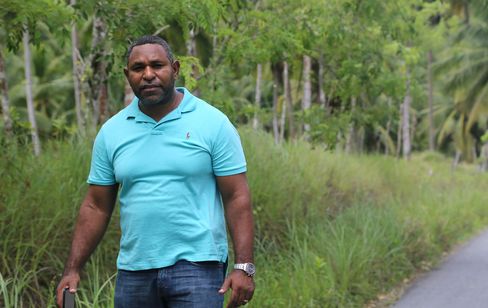News Date: September 09 2016
At the worst possible time, the Caribbean is running short of one of its most emblematic products.
Rich-world consumers have never been keener on the coconut. Starbucks wants the tropical fruit’s milk for lattes, Rihanna promotes its water as a trendy sports drink, and the price of coconut oil has jumped more than 50 percent in the past year.

Coconuts for export to U.S. in Coco Siri’s warehouse in Nagua.
Photographer: Ezra Fieser/Bloomberg
The Caribbean is practically synonymous with the coconut, so its farmers should be cashing in. For a bunch of reasons, they aren’t. Storms, droughts and the Lethal Yellowing disease, spread by plant-hopping insects, have wiped out entire farms; growers have failed to invest in new trees, or fertilizers to improve yields. Caribbean plantations have shrunk by about 17 percent since 1994, according to the UN’s Food and Agriculture Organization.“It’s fair to say that at this pace, the Caribbean is running out of coconuts,” said Compton Paul, coordinator of a regional coconut program at the Trinidad-based Caribbean Agricultural Research and Development Institute.
‘Too Early’
In Nagua on the Dominican Republic’s north coast, where Dioni Siri has his own trees and also buys from other farmers, production has dropped by about 60 percent in two decades, according to the local association of growers. Siri, who sells to export markets, says that quantity isn’t the only issue: many of the nuts that do get harvested aren’t up to scratch.
In his warehouse, he picks through a pile of the fruit, holding each one close to his ear and shaking it to see if it contains milk. When there’s no sound, the coconut is dumped on a growing pile of discards. “It was picked too early,” Siri says. “It’s not good enough. Our biggest problem is that the farmers aren’t growing enough quality coconuts.”
It’s a problem that nobody saw coming. Two decades ago, international demand was waning amid medical warnings that tropical oils could raise levels of artery-clogging cholesterol.
Coconuts sold for next to nothing in the Caribbean, where they’ve grown for five centuries since being introduced by Europeans traveling from the Indian Ocean. Often, they were just left to rot on their trees.Today, coconut milk is being sold as a healthier alternative to cow’s milk, and it’s a staple of recipes in the paleo-friendly cookbooks adored by the CrossFit crowd. Even the fruit’s husks turn out to be useful, filling car-seat cushions.
Celebrity Investors
And most sought-after of all is the coconut’s water, rich in potassium and other electrolytes. It’s on track to become a $4 billion industry by 2019, according to Technavio, a research company.
All Market Inc., the industry pioneer which began selling leading brand Vita Coco in 2004, now cracks about 1.6 million nuts a day, and can claim Rihanna and actor Matthew McConaughey among its celebrity investors. The company estimates that the U.S. market alone is already worth $1.2 billion, according to spokesman Arthur Gallego. “We’re focused on developing new products around the coconut,” he said. “We want to be to the coconut what Dole is to the pineapple.”
With buyers so eager, Vilma Da Silva and her husband gave up growing other cash crops on their 35-acre farm in Guyana’s Pomeroon region five years ago, and starting focusing on coconuts-for-water exports. They buy coconuts from about 60 other small farms, bottle the water and export it, receiving about $1.50 per liter. It’s been lucrative — revenue has doubled since they made the switch — but they’re running into supply constraints.
“We want to get into more international markets and export more but there aren’t enough farms to buy from,”’ Da Silva said.
Other countries are stepping in to meet demand. Worldwide, farmers have increased the amount of land planted with coconuts by 14 percent since 1994, according to the UN. Indonesia, the Philippines and India are the top producers.
‘Start Planting’
Meanwhile, with export-oriented Caribbean farmers like Siri and Da Silva buying up all the fruit they can, locals risk losing out. Typically, green coconuts for water have been so plentiful and cheap that any thirsty islander might buy one on the street corner, from a machete-wielding salesman who’d lop off the top and insert a straw. They still do — but prices are rising, while grocery shelves are filling up with thinned-out or even fake versions. Trinidad & Tobago’s Health Ministry in May confiscated bottles labeled as coconut water from stores, saying they contained only water and chemicals.

Dioni Siri – Photographer: Ezra Fieser/Bloomberg
It’s not the first time a developing-country staple has been caught up in a first-world food trend. Farmers that grow the finest coffees often can’t afford a bag of their roasted beans. And when protein-rich quinoa caught fire in the U.S., many consumers in Bolivia, one of the biggest producers, were priced out.
Melvin Bautista owns Coco Express del Caribe, one of the leading domestic coconut-water brands in the Dominican Republic. He says he can barely obtain the supplies he needs, as farmers sell to exporters instead, and has raised prices for a 16-ounce bottle by 20 percent this year, to about $1.50. Local farms are mostly “in very bad shape and the trees are very old.”
There’s only one solution, Bautista says: “Start planting more coconuts.”
News Source: Bloomberg

